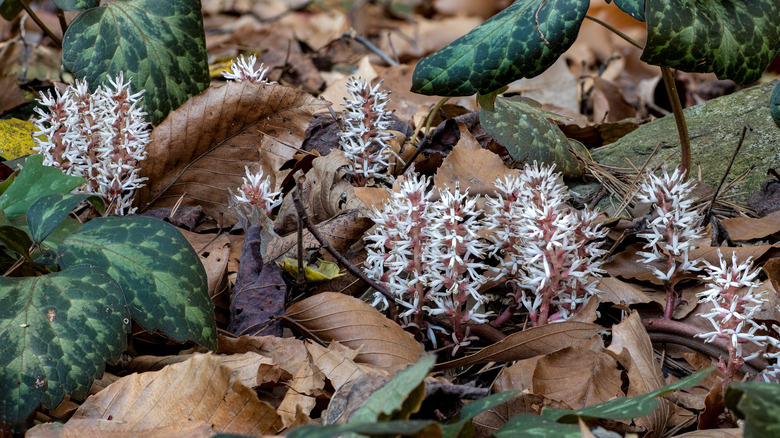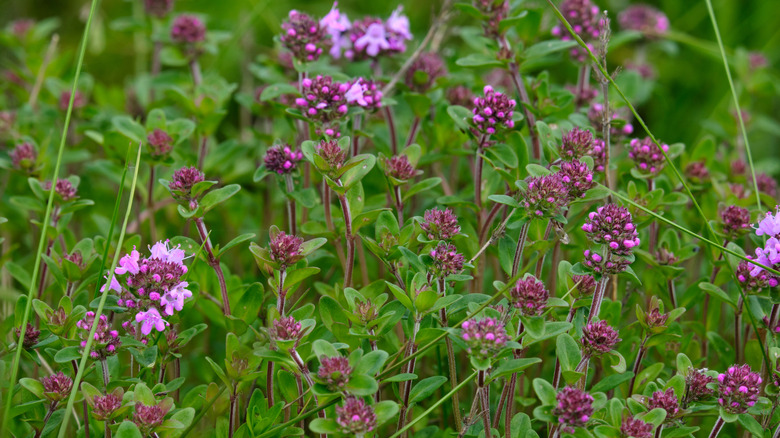The Dense-Growing Ground Cover That Beautifies A Shady Garden Walkway Or Path
If you're looking for a dense-growing ground cover that can beautify those shady garden areas next to a walkway or path, finding a lovely native species is ideal because it usually won't be invasive and should be relatively easy to grow. One such species is Allegheny spurge (Pachysandra procumbens) which is hardy down to USDA zone 5. It forms a lovely dense mat of fairly large evergreen or semi-evergreen leaves and produces fragrant, white blooms on 2 to 4 inch spikes in spring. In fact, this is one eye-catching ground cover that will thrive under trees for years to come.
For an expert opinion on this attractive ground cover, House Digest spoke exclusively to Andrey Likhman, owner and principal of Vandeck Builders, to ask whether he would recommend Pachysandra procumbens as a ground cover instead of grass. "Pachysandra procumbens is a solid option for shady areas where grass tends to struggle. It creates a dense, low-maintenance carpet that suppresses weeds and adds visual interest with its soft green leaves and subtle blooms. That said, it's not ideal for high-traffic areas or full-sun environments," he stated. When asked about the advantages of using this plant as a ground cover, Likhman said that Pachysandra is, "drought-tolerant once established, deer-resistant, and excellent for erosion control." There are, however, also some cons. "[It] can spread aggressively under ideal conditions, especially in moist, shaded areas. While it's not classified as highly invasive, it does need some boundary control in smaller gardens," Likhman said.
Should you use pachysandra over your entire yard or just in sections?
When finding a useful ground cover like Pachysandra that can easily replace a lawn, especially in shaded areas where grass struggles to grow, you might be tempted to use it as a grass substitute all over your yard. However, according Likhman, this is not always the best practice. "I'd recommend using Pachysandra for targeted zones rather than the entire yard — like shaded pathways, around trees, or between stepping stones," he said in his exclusive interview with House Digest. This certainly indicates that this is the perfect drought-resistant native spurge you should be planting for ground cover.
Likhman also gave some tips on how to replace grass with Pachysandra. "To replace grass, remove existing turf, amend the soil, and plant rooted cuttings or plugs 6 to 12 inches apart. Mulching in between will help with moisture retention and weed suppression during establishment," he added. For even more interest, there's a lovely cultivar called 'Silver Streak', which has outstanding large green leaves mottled with silvery-white in the fall and through winter. On top of that, you might like to explore some beautiful companion plants that grow well with Allegheny spurge, such as maidenhair ferns and oakleaf hydrangeas.
Maintenance requirements and alternatives to consider
Native Pachysandra is certainly not a plant that requires a lot of maintenance, which is exactly what you want from a ground cover. When speaking exclusively to House Digest, Likhman shared his advice for maintaining this plant. "It thrives in partial to full shade and prefers well-drained, slightly acidic soil. Water regularly until established, then scale back. Avoid heavy foot traffic and trim back in early spring to encourage fresh growth," he said.
But what about some of the more sunny spots in your yard? Likhman suggested some alternative choices. "For more sunlight or variety, creeping Jenny (Lysimachia nummularia) or Mazus reptans are excellent alternatives — both offer good coverage, color variation, and seasonal blooms. For a more drought-resistant option, try creeping thyme," he said. When looking at these alternatives, just remember that creeping Jenny is regarded as invasive in quite a few states, including Michigan, Connecticut, Indiana, Kentucky, Massachusetts, New Hampshire, Pennsylvania, Virginia, and Wisconsin. On the other hand, Mazus reptans is now known as Mazus miquelii, and while not on any invasive plants lists, it is regarded as an invasive weed in some northern states. Finally, if you're keen to use creeping thyme, select the Thymus serpyllum species, which is not on any invasive plant list.


